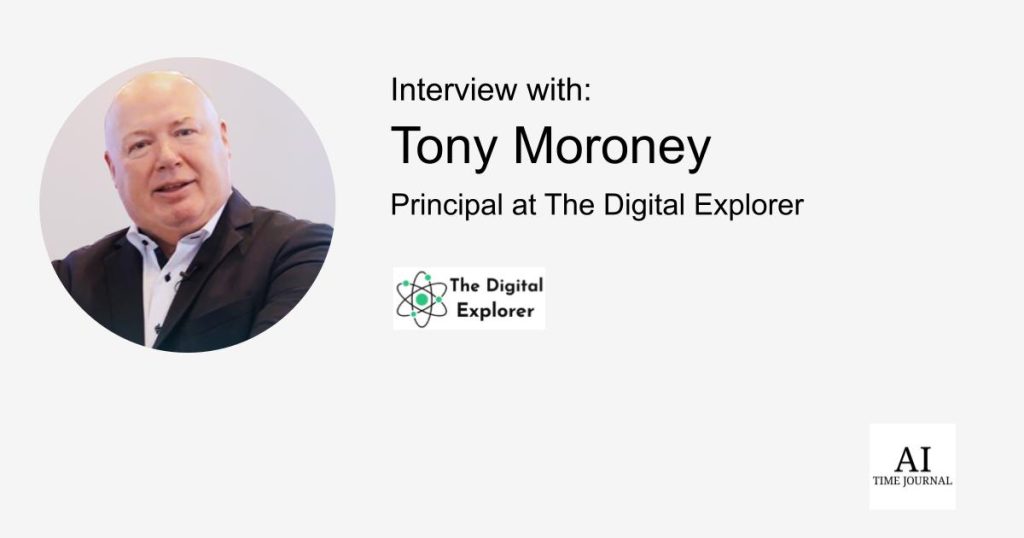
Tony Moroney, Principal at The Digital Explorer, shares his insights on the rapidly evolving financial services industry where digital disruption is reshaping traditional business models. This transformation is driven by advancements in artificial intelligence, machine learning, blockchain, cloud computing, and big data analytics, which enhance efficiency, improve customer experiences, and enable fintech companies to challenge traditional incumbents. Evolving consumer expectations and regulatory changes also play pivotal roles. Recognized as a Top Voice by LinkedIn and a Top 100 Thought Leader EMEA by Thinkers 360, Moroney discusses the impact of the metaverse on financial services and the promising applications of generative AI. He delves into misconceptions about digital transformation, balancing rapid innovation with regulatory compliance, and the leadership qualities essential for steering organizations through digital disruption. Join us as we uncover the future of financial services in a digital world.
As a globally renowned advisor specializing in strategy and digital transformation, what key factors do you believe are driving the current wave of digital disruption in the financial services industry?
The financial services industry is experiencing profound digital disruption driven by several critical factors. Technological advancements, including artificial intelligence, machine learning, blockchain, cloud computing, and big data analytics, are leading the charge. These innovations reshape the landscape, enabling new business models, enhancing efficiency, and improving customer experiences.
Evolving consumer expectations and the rise of fintech companies have intensified the competitive landscape. FinTechs challenge incumbents, offering innovative and user-friendly financial services in response to consumer demand for seamless, personalised, and convenient digital experiences. Concurrently, regulatory changes are playing a pivotal role in driving digital disruption. On one level, it’s about providing open and transparent systems; on another, the bar is set high regarding cybersecurity, data protection, and privacy. Additionally, regulations like open banking encourage sharing financial data with third-party providers, fostering competition from non-traditional sources, including retailers keen to embrace embedded finance and, more recently, buy now, pay later solutions.
Interestingly, despite significant investment in technology, the latest analysis by BCG suggests that banks alone, having spent more than $650 billion annually on technology for the past decade, still need to catch up with the omnichannel lifestyles their clients lead. While technological investment is critical, vision, effective implementation and alignment with consumer needs are essential for staying competitive and relevant.
You have been recognized by LinkedIn as a Top Voice and by Thinkers 360 as a Top 100 Thought Leader EMEA. How have these recognitions influenced your approach to advising on digital transformation and strategy?
Recognition as a Top Voice by LinkedIn and as a Top 100 Thought Leader EMEA by Thinkers 360 has been a humbling experience. They have reinforced my commitment to staying at the forefront of industry trends and best practices, motivating me to delve deeper into emerging technologies and innovative strategies and ensuring I provide my clients with the most current and relevant insights.
Ultimately, these recognitions enhance my credibility and trust with clients. They underscore the extensive investment I make in continually expanding my knowledge and understanding of the rapidly evolving digital landscape. They have also encouraged me to engage more actively with industry peers, contribute to meaningful conversations, and foster a collaborative approach to knowledge-sharing and problem-solving.
Given your expertise in the metaverse, how do you foresee its integration impacting the financial services sector in the next five years?
The metaverse is more about creating immersive experiences than technology. In the future, we might not use the term metaverse at all. We will simply talk about experiences.
Financial institutions’ interest in developing the metaverse has surged since late 2021, driven by the convergence of enabling technologies such as network and computing infrastructure, sensing technologies, artificial intelligence, and distributed ledger technologies. These foundational elements foster seamless and creative interactions, facilitating commercial activities.
As the metaverse evolves, it will drive demand for virtual financial services, creating opportunities to bring brands to life with engaging activities, unique service offerings and tailored customer experiences. Additionally, it offers innovative ways to promote financial literacy through interactive educational experiences, financial inclusion and operational efficiencies. However, the journey to fully integrating the metaverse has many challenges. Firms must address significant issues such as data privacy, platform functionality limitations, and the scarcity of specialised talent. Moreover, limited user adoption, high development and maintenance costs, integration complexities, cybersecurity and data protection pose substantial challenges.
With generative AI ranking high on your areas of expertise, what do you see as the most promising applications of this technology in transforming business operations?
Adopting generative AI in financial services presents a unique challenge. Previous technological disruptions took time to evolve and impact the sector, with the speed of adoption determined by factors such as awareness, internal adaptation, and ecosystem readiness. However, many customers are now using generative AI, and its performance and accuracy are steadily improving.
Traditionally, financial service firms have slowly adopted new technologies, often shielding their operations and technologies behind formidable barriers. Yet, generative AI has the potential to revolutionise products and services, providing a highly customised experience to customers and playing a crucial role in reducing risks, such as fraud.
Within the financial industry, a vast majority of financial services companies (91%) are either assessing AI or already using it in production, according to NVIDIA’s annual State of AI in Financial Services report. However, most financial institutions struggle to utilise data effectively. Artificial intelligence relies heavily on the quality of data fed into its systems. Financial providers risk making poor decisions, running inefficient operations, or serving customers with incorrect information if the data is inaccurate, confusing, or outdated. None of these outcomes are acceptable from a customer, regulatory, or brand perspective.
AI requires good data, and good data requires an AI-ready infrastructure. Additionally, financial services must navigate stringent data requirements, such as GDPR, and comply with impending AI legislation. Despite these challenges, financial services must seize this opportunity and move beyond cost and compliance applications, as technological advances may entice others, including Big Tech, to formally enter the market. Financial institutions can effectively integrate generative AI to enhance operational efficiency, improve customer satisfaction, and maintain a competitive edge in a rapidly evolving digital landscape.
As a keynote speaker on digital disruption, what are some of the most common misconceptions you encounter about digital transformation among business leaders?
There are several challenges with digital transformation. First, while most organisations will tell you they are engaging in digital transformation, many have not defined its meaning. This is surprising, given the significant amount of money spent to date. Most studies suggest that upwards of 80% of digital transformations fail. While this is a shocking statistic, it is expected because, in my view, most organisations never intended to be digitally transformed in the first place. Instead, the focus has been on technology implementation. Ironically, organisations would be better served if they dropped the word “digital” and focused instead on “transformation.”
Transformation implies transformative change through people, not just incremental change or new technologies. It is driven by a vision of what it will take to remain relevant and competitive. It is based on an understanding that the world is increasingly digitalised, which has implications for what our customers and stakeholders will expect. However, we are not transforming because of the technology itself. We may use technology to transform, but it is not the reason for transformation. Leaders must own the transformation. They must also recognise that this is about hearts and minds. We need to address what transformation means for our people and their roles in transformation.
How do you advise organizations to balance the need for rapid digital innovation with the requirement to manage risks and maintain regulatory compliance?
This requires a strategic and integrated approach underpinned by the vision and values of the organisation. Establishing a comprehensive risk management framework that includes regular risk assessments, mitigation strategies, and monitoring mechanisms is essential. This framework should be integrated into the innovation process to manage risks proactively.
Equally important is fostering a culture where compliance and risk management are considered integral to the innovation process. Engaging key stakeholders early in the process is crucial. This includes compliance officers, legal advisors, and risk management teams, whose input can help identify potential risks and regulatory requirements from the outset. This should be a collaborative effort, ensuring that all perspectives are considered and aligned with the organisation’s goals.
Organisations should regularly review and update their policies and procedures to ensure compliance with the latest regulations and standards. Maintaining open lines of communication with regulatory bodies is also critical, especially for regulated sectors such as financial services. The latest developments in generative AI provide a prime example as financial service providers and regulators work together to understand potential use cases, benefits, and associated risks. Collaborating with regulators can offer insights into upcoming regulatory changes and help organisations stay ahead of requirements.
Moreover, many jurisdictions have established regulatory sandboxes that facilitate experimentation in a controlled environment. These sandboxes allow organisations to test, refine, and commercialise minimum viable propositions while ensuring compliance and managing risks. By leveraging such resources, organisations can innovate rapidly without compromising regulatory and risk management standards.
What role do you believe leadership plays in successfully navigating digital disruption, and what qualities do you think are essential for leaders in this digital age?
Leadership plays a crucial role in successfully navigating digital disruption. Ultimately, leaders set the direction for their organisation, guiding it through the complexities of the digital age. Leaders must anticipate and embrace innovation. Sensemaking, adaptability, and communication are critical skills for a rapidly disrupted, hyper-connected, digitalised world.
Leaders must foster a culture of continuous learning, encouraging their teams to stay ahead of the developments and creating an environment where it is safe to challenge the status quo and experiment. Leaders must also let go; it is no longer about command and control structures where leaders are expected to have all the answers. It is about orchestrating and harnessing talent so the organisation can remain relevant and competitive. In my experience, the majority of leaders are not digital natives!
Leaders must also have a clear and compelling vision that should be communicated effectively to inspire, align, and achieve organisational buy-in. They must break down silos and promote cross-functional teamwork based on customer expectations. Additionally, leaders must have an ambidextrous mindset, effectively running their organisation while simultaneously preparing for the future. This is challenging and requires buy-in from all stakeholders, resilience, and an enduring commitment to transformation.
Can you share an example of a strategic digital business transformation initiative you have led that resulted in significant impact for a client?
I have led numerous strategic digital business transformation initiatives that have resulted in significant impacts for clients across various industries. As you will appreciate, I can’t provide specifics on client engagements. However, I can share some key themes.
A critical aspect is ensuring the entire leadership team is aligned in their understanding and collective ownership of digital transformation. This alignment is crucial for fostering a cohesive effort towards the common goal and organisational buy-in. Another critical theme is recognising that digital transformation is fundamentally about people. On one hand, it’s about meeting customer expectations and delivering excellent customer experiences. On the other hand, it’s about empowering employees to be the drivers of these transformative experiences. Employees collectively bring about the transformation. Data also plays an integral role. Leveraging data analytics helps organisations gain deeper insights into customer behaviour and preferences, enabling them to tailor their offerings to align with customer journeys.
By focusing on these themes: leadership alignment, customer-centricity, employee empowerment, and data-driven insights, I have successfully guided organizations through their digital transformation journeys.
In your opinion, how is the convergence of AI and automation reshaping traditional business models, and what should companies do to stay ahead of the curve?
Several trends characterise the convergence of AI and automation. Firstly, AI and automation are revolutionising operational efficiency. Businesses can significantly reduce costs and minimise errors by automating routine and repetitive tasks. This allows employees to focus on more strategic, creative, and value-added activities, improving productivity and innovation.
Secondly, AI is enhancing decision-making processes. With advanced data analytics and machine learning algorithms, businesses can gain deeper insights from vast data sets, including unstructured data. This enables more accurate forecasting, personalised customer experiences, and data-driven strategies that can adapt quickly to changing market conditions. Moreover, the integration of AI and automation is leading to the creation of new business models.
Organisations should adopt a proactive approach to AI and automation. This includes investing in technologies and infrastructure. Enhancing and supplementing employee skills is also paramount. Critically, leaders should focus on the responsible use of AI and embed ethical AI practices in their organisations, including addressing data privacy, transparency, and fairness considerations. Establishing robust governance frameworks and ensuring regulatory compliance is central to building trust with customers and stakeholders.
What are the key components of a successful digital transformation strategy, and how do you ensure that these components are effectively implemented in large organizations?
In my mind, organisations have a strategy, and effectively implementing this strategy differentiates the winners from others. Digital transformation is a means to deliver on the plan, but it is not the strategy.
Successful digital transformation hinges on several key components, and ensuring these components are effectively implemented in large organisations requires a structured and committed approach. There must be a clear and compelling vision. This vision should articulate the organisation’s future state and the role of digital transformation in achieving it. It should be communicated effectively to inspire and align all stakeholders.
Leadership commitment is crucial. Digital transformation must be driven from the top, with leaders demonstrating a solid commitment to change and setting the tone for the rest of the organisation. This involves actively participating in and supporting transformation efforts, particularly in removing obstacles and roadblocks. Leaders must also invest in upskilling and reskilling their employees to ensure they have the necessary skills and feel supported and encouraged to experiment and embrace new technologies and ways of doing things.
Leveraging data and analytics to gain insights into customer behaviour is critical. Organisations must invest in the right technologies and systems, including scalable and flexible IT infrastructure, data analytics capabilities, and cybersecurity measures to protect digital assets. But it’s not just about the technology. Digital transformation requires a mindset and cultural change, too. If we don’t think differently about the business, we won’t act differently, and the culture remains the same, which in many cases means an analogue culture in a digital world. This is a recipe for failure.
Leaders should ensure robust governance frameworks are in place to oversee the transformation process. This includes establishing clear roles and responsibilities, setting up decision-making bodies, and ensuring accountability at all levels. Regular monitoring and evaluation of progress are vital to keep the transformation on track and make necessary adjustments. Most importantly, the metrics must change because if they don’t, the old behaviours continue to be rewarded, and the commitment to digital transformation is immediately undermined.
Large organizations should adopt a phased approach to implement these components effectively. This involves setting clear milestones and objectives, prioritizing initiatives that deliver quick wins, and scaling up successful pilots. Quick wins are essential as they build commitment and momentum. No organization will wait several years to determine if its digital transformation efforts are working. Regular communication and engagement with stakeholders at all levels are crucial to maintaining momentum and addressing resistance to change.

 4 months ago
73
4 months ago
73







 English (US) ·
English (US) ·